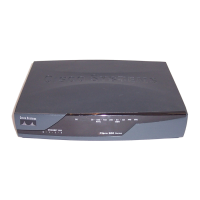
Do you have a question about the Cisco CISCO851-K9 - 851 Integrated Services Router and is the answer not in the manual?
| Model | CISCO851-K9 |
|---|---|
| Device Type | Router |
| Enclosure Type | Desktop |
| Connectivity Technology | Wired |
| Flash Memory | 32 MB |
| Data Link Protocol | Ethernet, Fast Ethernet |
| Authentication Method | RADIUS, TACACS+ |
| Wireless | No |
| VPN Support | Yes |
| Firewall | Yes |
| Operating System | Cisco IOS |
| Weight | 2.2 lbs |
| LAN Ports | 4 x 10/100 |
| Routing Protocol | BGP, EIGRP, OSPF |
| Encryption Algorithm | DES, AES, 3DES |
| Compliant Standards | IEEE 802.1D, IEEE 802.1Q |
| Features | DHCP support, NAT support, VPN support, VLAN support |
| Interfaces | 1 x console - RJ-45 - management, 4 x Fast Ethernet - RJ-45 - LAN, 1 x Fast Ethernet - RJ-45 - WAN |
| Dimensions | 10.1 in x 7.9 in x 1.8 in |
Identifies the intended audience for the configuration guide.
Outlines the structure and content of the guide for easy navigation.
Details the formatting, symbols, and command syntax conventions used.
Lists other Cisco publications providing related information on routers.
Provides information on obtaining documentation and submitting service requests.
Lists supported interfaces and their associated port labels on routers.
Explains how to view the router's default configuration on startup.
Lists essential information required prior to network configuration.
Covers configuring global parameters, interfaces, and command-line access.
Describes how to manually configure fixed routing paths through the network.
Explains how network protocols adjust paths automatically based on traffic/topology.
Details the steps to configure the Routing Information Protocol (RIP).
Explains how to configure the Enhanced Interior Gateway Routing Protocol (EIGRP).
Provides configuration examples for Ethernet-based network deployments.
Provides configuration examples for DSL-based network deployments.
Enables communication through the router using a single IP address.
Configures the router's Fast Ethernet WAN interfaces for PPPoE.
Configures a dialer interface for handling client traffic and PPPoE sessions.
Sets up NAT to translate private IP addresses to public ones.
Shows a sample configuration file for the PPPoE scenario with NAT.
Details commands to verify the PPPoE and NAT configuration.
Configures a dialer interface for PPPoA sessions on ATM interfaces.
Details steps to configure the ATM interface for WAN connection.
Covers the default configuration settings for ADSL signaling.
Details the steps to configure SHDSL signaling for the DSL controller.
Sets up NAT for the ATM WAN interface with dynamic translation.
Shows a sample configuration file for the PPPoA scenario with NAT.
Explains DHCP's role in automatic IP address allocation for clients.
Details steps to configure the router to act as a DHCP server.
Describes how to configure VLANs to segment networks into logical groups.
Explains how to assign specific switch ports to configured VLANs.
Provides commands to view and verify the configured VLAN setup.
Sets up the Internet Key Exchange (IKE) policy for VPN negotiation.
Defines attributes to be downloaded to the remote VPN client.
Applies mode configuration to the crypto map for IKE queries.
Enables policy lookup through the Authentication, Authorization, and Accounting (AAA) model.
Defines acceptable combinations of IPSec security protocols and algorithms.
Configures dynamic crypto map entries for IPSec negotiation.
Applies crypto maps to interfaces for evaluating IPSec traffic.
Sets up the Easy VPN remote configuration and assigns it to the outgoing interface.
Shows commands to verify the configured Easy VPN settings.
Explains GRE tunnels for VPNs between routers and remote devices.
Sets up the Internet Key Exchange (IKE) policy for VPN negotiation.
Defines attributes to be downloaded to the remote VPN client.
Enables policy lookup through AAA for VPN configurations.
Defines acceptable combinations of IPSec security protocols and algorithms.
Configures crypto map entries for IPSec negotiation.
Applies crypto maps to interfaces for evaluating IPSec traffic.
Details steps to configure a GRE tunnel for VPN connections.
Creates access lists to prevent unauthorized traffic from reaching the network.
Defines firewall inspection rules for TCP, UDP, and application protocols.
Applies access lists and inspection rules to network interfaces.
Shows a sample configuration file for a simple firewall scenario.
Creates and configures the root radio station for the wireless LAN.
Configures integrated routing and bridging on VLANs for wireless connectivity.
Configures subinterfaces for each root station on the wireless interface.
Shows a sample configuration file for a wireless LAN scenario.
Shows a consolidated sample configuration integrating previous chapters' features.
Covers authentication, authorization, and accounting (AAA) for router security.
Details dial backup and remote management capabilities for router connectivity.
Provides guidance on identifying and resolving router problems.
Explains AAA as the primary framework for implementing router security features.
Simplifies security configuration by disabling vulnerable services and enabling defenses.
Details how to permit or deny network traffic based on IP addresses and protocols.
Configures a stateful firewall by inspecting packets and monitoring connection states.
Enhances firewall protection by taking action on policy-violating packets.
Covers site-to-site and remote access VPNs using IPSec and GRE.
Details the three methods available to activate the dial backup feature.
Lists the limitations and support summaries for the dial backup feature.
Explains how to configure dial backup and remote management using console/aux ports.
Details configuring dial backup and remote management using the ISDN S/T port.
Provides initial steps and connection requirements for troubleshooting.
Lists information to have ready before contacting Cisco or a reseller.
Provides steps to verify and troubleshoot ADSL connection issues.
Offers guidance on verifying and troubleshooting SHDSL connection problems.
Lists essential commands for troubleshooting ATM interfaces.
Describes various methods available for upgrading router software.
Provides steps to recover lost enable or enable-secret passwords.
Introduces the Cisco SDM tool for router configuration and monitoring.
Explains how to configure the router using terminal emulation software on a PC.
Describes the hierarchical structure of Cisco IOS command modes.
Explains how to use the question mark (?) and arrow keys for command assistance.
Details commands for setting secure and unencrypted passwords for EXEC mode.
Guides users on how to enter global configuration mode for router changes.
Provides tips on abbreviating commands and handling CLI errors.
Explains how to save running configuration changes to NVRAM.
Summarizes key Cisco IOS software basics and command usage tips.
Directs users to relevant chapters for further configuration tasks.
Explains ADSL technology for high-speed data transmission over phone lines.
Describes SHDSL technology for symmetrical high-speed data transmission.
Explains how network protocols enable data transfer between sources and destinations.
Lists and briefly describes available routing protocols like RIP and EIGRP.
Explains PAP and CHAP for authenticating PPP sessions.
Describes TACACS+ for remote access authentication and security services.
Details supported network interface protocols like Ethernet and ATM.
Explains dial backup for providing protection against WAN downtime.
Describes NAT's mechanism for privately addressed networks to access registered networks.
Combines NAT and PPP/IPCP for automatic WAN IP address negotiation.
Combines DHCP server and relay for IP network configuration.
Describes QoS parameters for providing better service to selected network traffic.
Explains how access lists approximate session filtering.
Guides users on how to access the ROM monitor via console port.
Lists available commands to interact with the ROM monitor.
Describes the syntax and usage of common ROM monitor commands.
Details loading software via TFTP from ROM monitor for disaster recovery.
Explains the virtual configuration register and its function.
Describes downloading software or config files via the console port.
Lists ROM monitor debugging commands for analyzing system issues.
Explains how to exit ROM monitor mode and boot the Cisco IOS image.
Lists currently assigned TCP and UDP port numbers for network services.


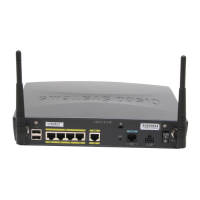



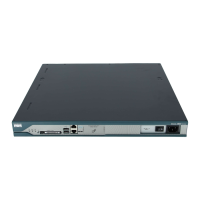
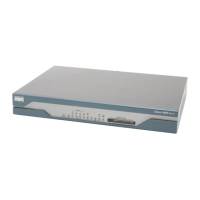

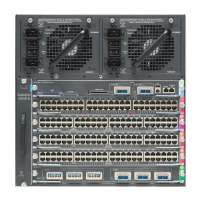


